|
The Callanan/Ellsworth Depot
The Ellsworth depot
was moved from Callanan when the Toledo and Northwestern Railway came through
Ellsworth in 1880. The depot was a two story building with
the agent and his family living on the second floor until 1950 when the
depot was remodeled. Oscar Fossum was one of the first agents
while Wilford Rash was the last agent, having served for 10 and one half
years.
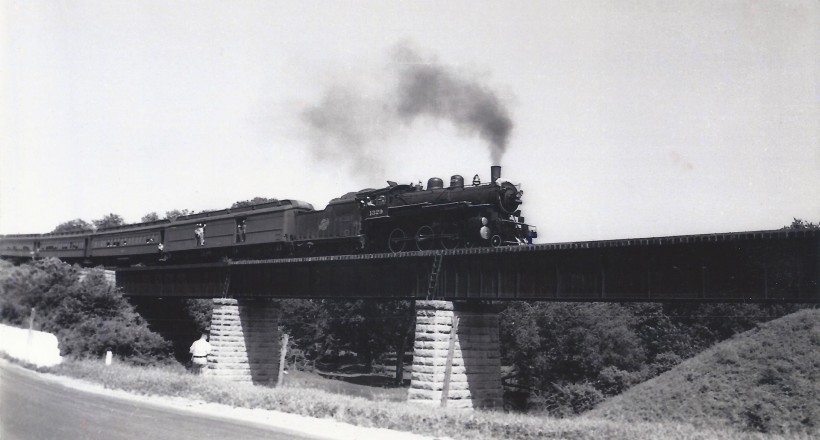
(Click for a larger view.)
Coming from Jewell Junction, this train crosses
the South Skunk River on the way into to Ellsworth.
Railroads were quite important to every community.
There were four passenger
trains available during the twenty four hours with three mail deliveries
each day. Several freight trains carried passenger cars as well.
People would go down to the depot to meet their relatives and friends.
Others would go down to visit. They enjoyed watching the trains coming
in. One could hear the whistle from quite a distance. There
were many long freight trains, too, which would move the farmers' grain,
hogs and cattle. They would bring furniture, implements, groceries
and other supplies for the stores.
The last timetable listing
scheduled for passenger service was dated June 27, 1954. The
succeeding timetable dated September 26, 1954 listed only mixed train service
and bus service. Freight trains still go through Ellsworth
(This was true in 1980, when the Centennial Story was published), bring
and pick up full freight cars; however, they are billed out of Jewell.
(This text is from The Centennial Story of Ellsworth.)
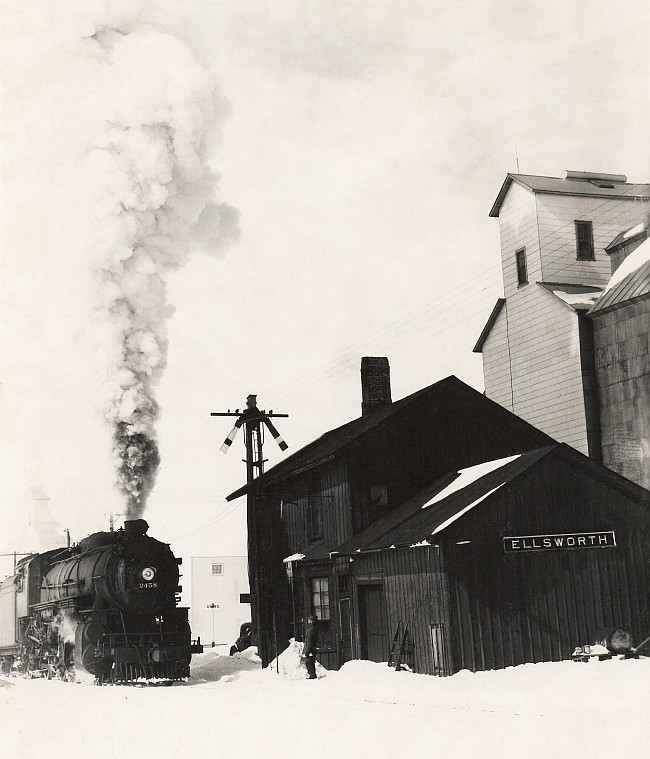
This photo from the 1940s shows a locomotive that has
come from Jewell (from the west) parked at the two-story Callanan/Ellsworth
depot. This was a few years before the second story was removed.
The second story was used as a home for the railroad agent and his family.
Learn about the recent history of
the Ellsworth Depot (on Pages 8).
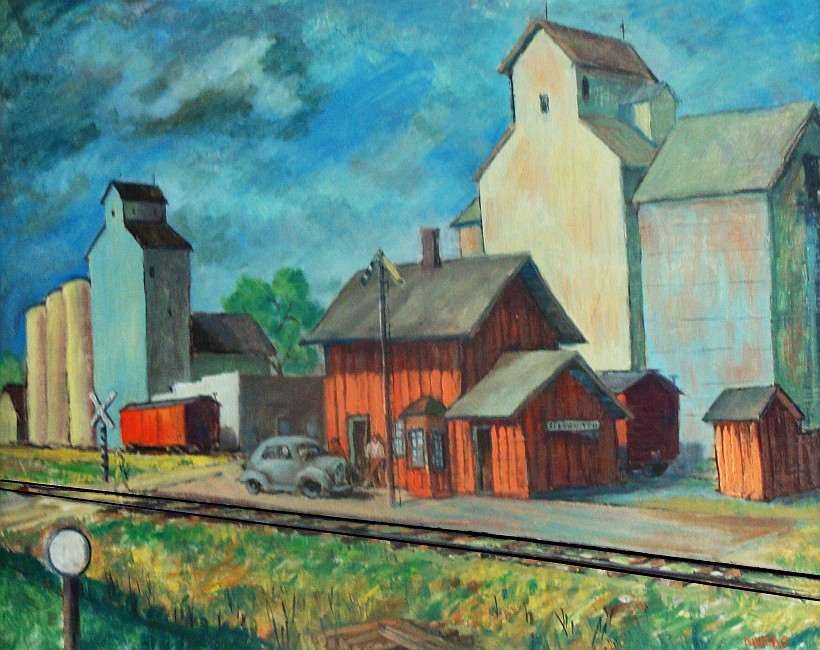
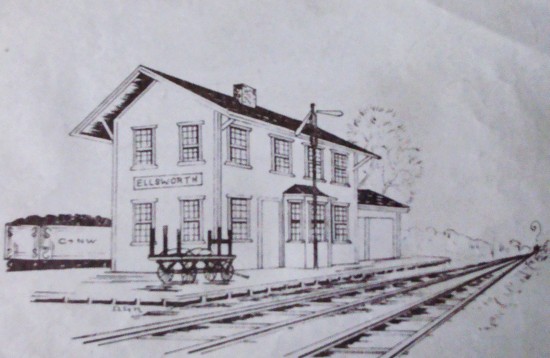
This drawing shows the two-story construction of the
Callanan/Ellsworth depot before the second story was removed.
The second story was used as living quarters for the
stationmaster and his family. The Ellsworth Depot, built about 1877
or 1878 in the early settlement known as Callanan, was brought to Ellsworth
three years later to become Ellsworth's railroad Depot.
See images of other
similarly aged depots in this area. Those images show more two-story
depots (from the same time, about 1876 or so) in other nearby central Iowa
communities.
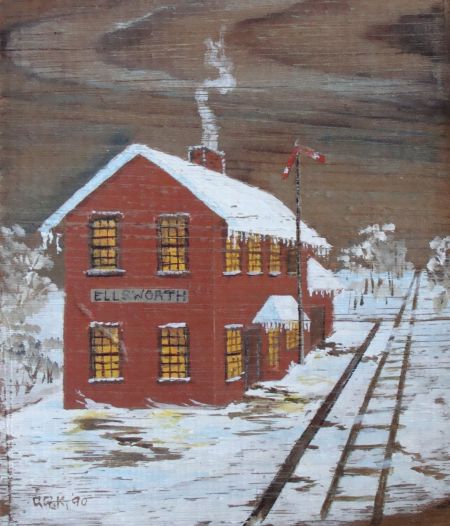
This painting of the Ellsworth depot (from the early
days)
was painted on a piece of wood by Genevieve
Kuhfus in 1990.
Genevieve labeled her art work by writing on the back
of this piece of wood,
"Chicago & Northwestern Depot, Ellsworth, Iowa
Board with painting is from the Freight Office."

1940s view of the east side of Main Street
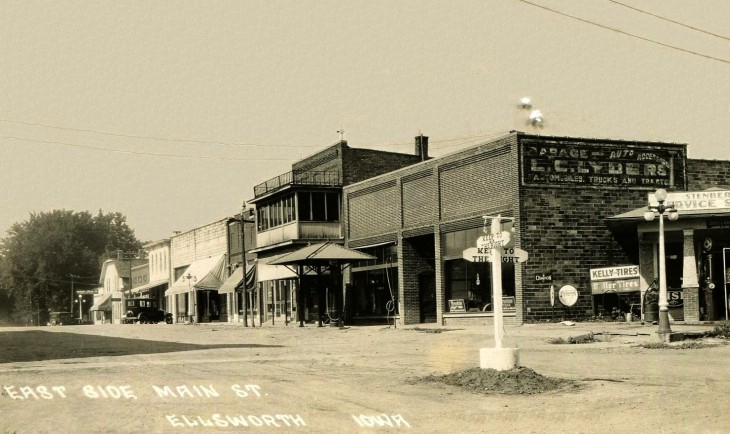

Memorial Day traditions in Ellsworth
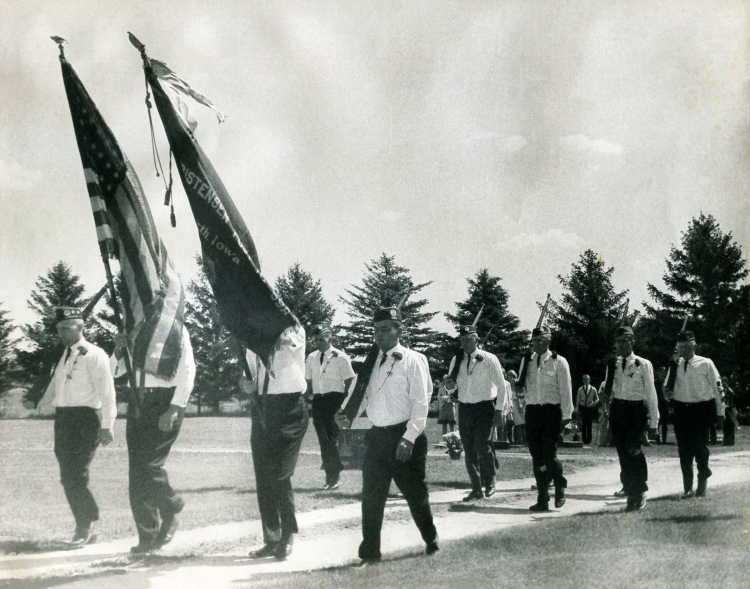
|
|
childhood memories from the 1920s:
Punctuating the months
of summer vacation were two national holidays, Memorial Day and the "Fourth".
Because rural school sessions were traditionally of only eight months in
the early twenties, Memorial Day, or Decoration Day, seemed to come in
the heart of the summer. In our community it was a day of great importance,
a day of special remembering of the dead, and especially the war dead,
as well as a day to honor veterans from all wars in which our country had
been engaged.
At our (country) home the
national flag was taken from storage immediately upon arising and hung
from its two rings flat against the porch wall, proclaiming for all passersby,
though they might be few and far between, that on this day we would pause
to give honor to those who had proudly served their country. As a
family we took special pride in the flag hung so colorfully in the brightness
of the new day, the sun just peering over the horizon, and with not the
slightest breeze to ruffle the early morning air. On the evening
of the preceding day we had joined the numerous visitors to the nearby
cemetery to decorate ancestral graves, and so on this beautiful morning
the cemetery was a sight to behold. Walking among the graves, my
parents remembered this one and that one who had passed on.
At mid-morning we joined others
of the locality for the Memorial Day service at the cemetery, at which
a color guard was schduled to shoot a volley of blank shots over the grave
of each departed soldier. A pastor gave a brief address, there was
a vocal rendition - a capella, and then the shots rang out. Startled
youngsters whimpered and clung to the security of a mother's skirts.
After the crowd had dispersed, boys had a heyday collecting the empty shell
casings, and adults renewed old acquaintances returning for the day to
decorate graves of departed parents and to pause briefly in memoriam.
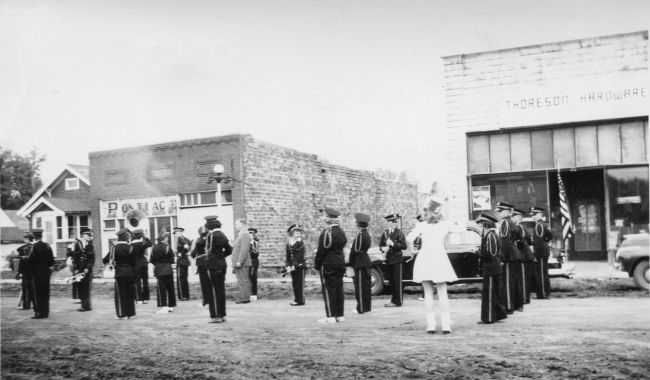
The band's program on Main Street
before marching first to the School, and then out
to the cemetery
A much more impressive service
brought us all into town for the afternoon. After a band concert
of national tunes on main street there was a march to the schoolhouse gymnasium
by the band, the color guard, and a band of preschool youngsters serving
as flower bearers. At the schoolhouse they formed a procession,
their entrance creating a solemn moment of rememberance. Marching
in the color guard were beterans of World War I and of the Spanish American
War. Veterans from the Civil War were of a great age and few
in number.
They were privileged to be seated
on the stage along with local pastors and the speaker of the day, usually
a figure in government, some of whom were bound to be politicians, others
real statesmen. Some fine oratory was delivered from that stage,
and always an older child delivered the famed Lincoln's Gettysburg Address
with great expression, having committed the whole to memory. In my
memory there were only two Civil War veterans in our community, and one
was my grandfather, John M. Johnson. At the end of the ceremony,
a flower girl came up onto the stage to pin a flower on the lapel of these
expecially honored veterans.
Memories of my grandfather
include visits to our home on threshing days to observe the interesting
activities, but he spent much time in a rocker in the shade of the porch,
since at his age there was a limit to the amount of heat he could stand.
He entertained us as children with tales of his service in the war.
I was impressed at his statemtnt that he had walked across the entire United
States. As a young child, he had come to America with his parents,
while my maternal grandfather, John O. Ringstad, had emigrated as a young
man at about the close of the Civil War. Grandpa Ringstad shared
our family home intermittently in his late years. He was a born storyteller,
and his tales of pioneering enriched our lives, giving us an interest in
local history and an appreciation of twentieth century progress.
He witnessed the founding of the town of Ellsworth and was the first postmaster
there.
Memorial Day festivities did
not end with the program at the gymnasium, but progressed to a cemetery
just beyond the town. Here the performance of the morning at country
cemeteries was repeated on a much larger scale. The band of flower
girls and boys was led to each flag decked soldier's grave and, two by
two, proceded to lay a spray of flowers on each honored grave. Family
members traditionally gathered about the graves of their departed family
members. Later we always stopped at the home of my grandfather for
a bit of lunch, extending the visiting, and, reluctantly, ending the lovely
day of remembrance. |
| The preceding text is an excerpt from Echoes of Spring
Valley, written by J. Clarine J. Boyken telling about her experiences
living in rural Hamilton County during the 1920s. Spring Valley was
a one room school in Scott Township located a few miles southeast of Ellworth. |

1942-1943

The Ellsworth High School
Girls Basketball team
from 1942-1943

Click to view advertisements published in the The
Ellsworth News of March 24, 1943.
1943-1944

The Ellsworth High School
Girls Basketball team
from 1943-1944
Pictured above, from left,
Marilyn Sogard, Freda Ward,
Bonnie Johnson, ?, Joan Hovda,
Shirley Voga, Avis Hovda,
Ruth Hanson, Kathryn Sogard,
Ruth Thoreson, Dorothy Johnson,
and Charlene Loux, holding the ball.
|

|
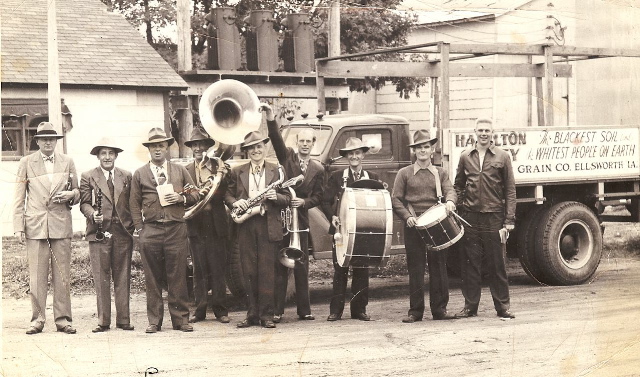
Do you know the year of this photo of a band and truck
waiting for a parade?
And do you know the names of the men in the picture?
The sign on the side of the truck says,
"Hamilton County - The Blackest Soil & the
Whitest People on Earth"
|

